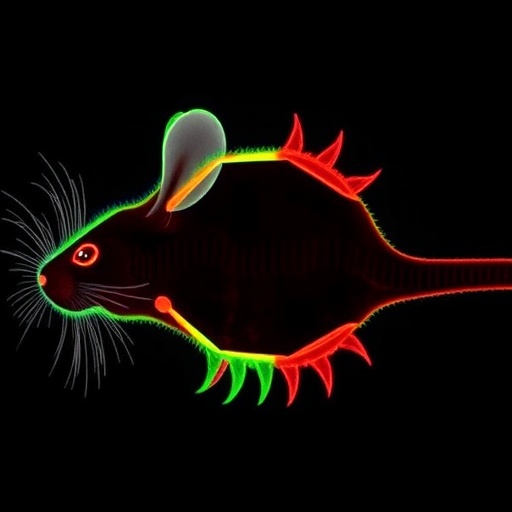A groundbreaking advancement in the field of vision restoration has recently emerged from the intersection of nanotechnology and biomedical engineering. Researchers have developed a novel retinal prosthesis constructed from tellurium nanowires, which has demonstrated remarkable efficacy in restoring vision to blind animal models. This innovative approach not only aims to restore basic visual function but also enhances the eye’s capability to detect near-infrared light, a development that holds promising implications for future ocular therapies.
The retina, a thin layer of tissue at the back of the eye, plays a crucial role in converting light into the electrical signals sent to the brain. In degenerative conditions affecting the retina, such as retinitis pigmentosa or age-related macular degeneration, this process is severely disrupted, ultimately leading to blindness. Traditional treatments have struggled with limitations such as electrical interference and insufficient long-term impacts. However, the introduction of a retinal prosthesis made from tellurium offers a fresh perspective on restoring vision.
Tellurium is a unique element known for its semiconductor properties, making it an excellent choice for developing nanostructured devices. The researchers carefully engineered tellurium nanowires and then integrated them into a three-dimensional lattice framework. This novel architecture facilitates easy implantation into the retina while enabling efficient conversion of both visible and near-infrared light into electrical impulses. By adopting this approach, the researchers ensured that the prosthesis would function effectively in various lighting conditions, a significant consideration for practical application in real-world scenarios.
In preclinical trials, the team implanted the tellurium nanowire prosthesis into genetically blind mice. The results were nothing short of remarkable; the newly implanted devices successfully restored spontaneous reflexes in the pupils. This response indicates that the prosthesis could effectively mimic natural retinal function, allowing for the appropriate responses to light, which is crucial for any visual system. Moreover, further testing revealed that the blind mice equipped with the implants showed substantial improvement in various behavioral tests, such as locating LED lights, demonstrating a nearly normal level of performance compared to sighted control mice.
One of the most significant advantages of this new prosthesis is its capability to detect near-infrared light. The ability to perceive light in this spectrum can enhance contrast perception and improve vision under low-light conditions, potentially transforming how individuals with visual impairments navigate the world. Near-infrared detection could provide users with essential visual cues that would otherwise remain undetectable, effectively enhancing their overall quality of life.
Safety and biocompatibility are paramount when considering any implantation device. The tellurium nanowire prosthesis has shown promising results in this regard as well. In studies conducted with crab-eating macaques, which serve as an important model for human anatomy and physiology, the implant was well tolerated. There were no adverse reactions observed, suggesting that this new technology could be safely applied in clinical settings. Testing on sighted macaques also demonstrated that the prosthesis heightened the eye’s sensitivity to near-infrared light, further supporting its potential for use in vision restoration therapies.
The implications of this technology extend beyond mere vision restoration. The nanowire design allows for future modifications and adaptations, which could pave the way for even more advanced retinal prostheses capable of interfacing with neural circuitry more intricately. As researchers continue to improve upon this technology, the prospect of integrating more sophisticated capabilities, such as color recognition and enhanced depth perception, becomes closer to reality.
However, as with any new medical technology, the road to clinical application is fraught with challenges. Cost-effectiveness is a significant hurdle that researchers now face. The affordability and accessibility of this technology will determine its potential impact on patients with vision loss. Collaborations with industry partners and investment in research will be vital in bringing this technology to market and ensuring it reaches a broader population of users.
In addition to the technical advancements, this development underscores the critical need for continued research in the area of vision restoration. Traditional approaches often face significant barriers to success, reinforcing the importance of innovative and integrative strategies. By focusing on the underlying biophysics of vision and harnessing the advantages of nanotechnology, researchers can forge new pathways towards enabling the visually impaired to regain their sight.
The long-term success of these technologies will not only rely on the scientific advancements that pave the way but also on comprehensive frameworks that facilitate regulatory approvals, clinical trials, and eventually, patient access. Ongoing dialogue among researchers, regulatory bodies, and advocacy groups will be essential in driving these developments forward. The potential impact of such a breakthrough in artificial vision cannot be overstated, as millions of people worldwide live with varying degrees of blindness and visual impairment.
In conclusion, the development of a tellurium nanowire retinal prosthesis signifies an exciting leap forward in restoring vision. This research illuminates the pathway for future innovations that could revolutionize how we understand and treat visual impairments. By transforming light into meaningful visual signals, this technology not only opens up new avenues for clinical applications but also rekindles hope for individuals facing the challenges of blindness. The journey from laboratory to patient is undoubtedly long, yet the prospects ahead are profound.
Subject of Research: Retinal prosthesis using tellurium nanowires
Article Title: Tellirium nanowire retinal nanoprosthesis improves vision in models of blindness
News Publication Date: 5-Jun-2025
Web References: Journal article
References: Not Applicable
Image Credits: Not Applicable
Keywords
Nanotechnology, retinal prosthesis, near-infrared light, vision restoration, biocompatibility, tellurium nanowires.




